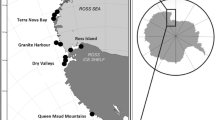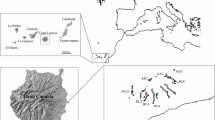Abstract
The spatial genetic structure of the widespread orchid Serapias vomeracea ssp. vomeracea and of the two rare S. vomeracea ssp. laxiflora and ssp. orientalis was examined using nuclear microsatellites. The three taxa showed low mean allele number (3.2), frequent significant deviations from the HW equilibrium (13 out of 20 populations) and intermediate to high gene diversity. F-statistics indicated either low or highly unpredictable levels of gene flow, in line with a not significant isolation by distance. Demographic tests suggested that most of populations experienced a size decline and show a small effective population size. The heterozygote excess detected in many populations could be the consequence of non-random mating due to the nonrewarding pollination strategy of Serapias. Hence, the divergence of lineages within the genus could be driven by a combination of stochastic forces such as drift and bottlenecks, as well as locally selective forces.
Similar content being viewed by others
References
J. D. Ackerman (1986) ArticleTitleMechanisms and evolution of food-deceptive pollination systems in orchids Lindleyana 1 108–113
Ackerman J. D., Zimmerman J. K. (1994) Bottlenecks in the life history of orchids: resources, pollination, population structure, and seedling establishment. In: Pridgeon A. M., (ed.) 14th World Orchid Conference, HMSO, London, pp. 125–129.
R. Alexandersson J. Ågren (2000) ArticleTitleGenetic structure in the no-rewarding, bumblebee-pollinated orchid Calypso bulbosa Heredity 85 401–409 Occurrence Handle11122418 Occurrence Handle10.1046/j.1365-2540.2000.00777.x Occurrence Handle1:CAS:528:DC%2BD3MXkvFWrsQ%3D%3D
J. Arditti A. K. A. Ghani (2000) ArticleTitleTansley Review N°110. Numerical and physical properties of orchid seeds and their biological implications New Phytol. 145 321–367 Occurrence Handle10.1046/j.1469-8137.2000.00587.x
P. Arduino F. Verra R. Cianchi W. Rossi B. Corrias L. Bullini (1996) ArticleTitleGenetic variation and natural hybridization between Orchis laxiflora and Orchis palustris (Orchidaceae) Pl. Syst. Evol. 202 87–109 Occurrence Handle10.1007/BF00985819 Occurrence Handle1:CAS:528:DyaK28XmvVWitLY%3D
A. M. Arft T. A. Ranker (1998) ArticleTitleAllopolyploid origin and population genetics of the rare orchid Spiranthes diluvialis Amer. J. Bot. 81 175–184
H. Baumann S. Künkele (1989) ArticleTitleDie Gattung Serapias L. – eine taxonomische Übersicht Mitteilungsblatt Arbeitskreis Heimische Orchideen Baden-Württemberg 20 10–651
M. A. Beaumont (1999) ArticleTitleDetecting population expansion and decline using microsatellites Genetics 153 2013–2029 Occurrence Handle10581303 Occurrence Handle1:STN:280:DC%2BD3c%2FltVKqsQ%3D%3D
P. Beerly J. Felsenstein (1999) ArticleTitleMaximum-likelihood estimation of migration rates and effective population numbers in two populations using a coalescent approach Genetics 152 763–773
M. I. Brookes Y. A. Graneau P. King O. C. Rose C. D. Thomas J. L. B. Mallet (1997) ArticleTitleGenetic analysis of founder bottlenecks in the rare british butterfly Plejebus argus Conserv. Biol. 11 648–661 Occurrence Handle10.1046/j.1523-1739.1997.96163.x
M. A. Case (1994) ArticleTitleExtensive variation in the levels of genetic diversity and degree of relatedness among five species of Cypripedium (Orchidaceae) Amer. J. Bot. 81 110–122 Occurrence Handle10.2307/2445631
M. Chase R. Kesseli K. Bawa (1996) ArticleTitleMicrosatellite markers for population and conservation genetics of tropical trees Amer. J. Bot. 83 51–57 Occurrence Handle10.2307/2445953
J. M. Cornuet G. Luikart (1996) ArticleTitleDescription and power analysis of two tests for detecting recent population bottlenecks from allele frequency data Genetics 144 2001–2014 Occurrence Handle8978083 Occurrence Handle1:STN:280:ByiC3s3mtlU%3D
S. Cozzolino A. Widmer (2005) ArticleTitleOrchid diversity: an evolutionary consequence of deception? Trends Ecol. Evol. 20 487–494 Occurrence Handle16701425 Occurrence Handle10.1016/j.tree.2005.06.004
S. Cozzolino M. E. Noce A. Musacchio A. Widmer (2003) ArticleTitleVariation at a chloroplast minisatellite locus reveals the signature of habitat fragmentation and genetic bottlenecks in the rare orchid Anacamptis palustris (Orchidaceae) Amer. J. Bot. 90 1681–1687
A. Dafni (1984) ArticleTitleMimicry and deception in pollination Annual Rev. Ecol. Syst. 15 259–278 Occurrence Handle10.1146/annurev.es.15.110184.001355
A. Dafni P. Bernhardt (1990) ArticleTitlePollination of terrestrial orchids of Southern Australia and the Mediterranean region. Systematics, ecological and evolutionary implications Evol. Biol. 24 193–252
A. Dafni Y. Ivri N. B. M. Brantjes (1981) ArticleTitlePollination of Serapias vomeracea Briq. (Orch.) by imitation of holes for sleeping solitary male bees (Hym.) Acta Bot. Neerl. 30 69–73
P. Delforge (1994) Guide des Orchidées d'Europe, d'Afrique du Nord et du Proche-Orient Delachaux et Niestlé Lausanne
J. J. Doyle J. L. Doyle (1990) ArticleTitleIsolation of plant DNA from fresh tissue Focus 12 13–15
L. C. Ellstrand D. R. Elam (1993) ArticleTitlePopulation genetic consequences of small population size: Implications for plant conservation Annual Rev. Ecol. Syst. 24 217–242 Occurrence Handle10.1146/annurev.es.24.110193.001245
P. R. England A. V. Usher R. J. Whelan D. J. Ayre (2002) ArticleTitleMicrosatellite diversity and genetic structure of fragmented populations of the rare, fire dependent shrub Grevillea macleayana Molec. Ecol. 11 967–977 Occurrence Handle10.1046/j.1365-294X.2002.01500.x Occurrence Handle1:CAS:528:DC%2BD38Xls1arsr4%3D
A. Felicioli F. Strumia L. Filippi M. Pinzauti (1998) ArticleTitleObservations on the relation between orchids of the genus Serapias and their pollinators in an area of central Tuscany Frustula Entomologica 21 103–108
I. R. Franklin (1980) Evolutionary change in small populations M. E. Soulè B. M. Wilcox (Eds) Conservation biology, an evolutionary-ecological perspective Sinauer Sunderland, MA 135–149
A. L. Gentry C. Dodson (1987) ArticleTitleDiversity and biogeography of neotropical vascular epiphytes Ann. Missouri Bot. Gard. 74 205–233 Occurrence Handle10.2307/2399395
M. A. Gitzendanner P. S. Soltis (2000) ArticleTitlePatterns of genetic variation in rare and widespread plants congeners Amer. J. Bot. 87 783–792 Occurrence Handle10.2307/2656886
P. Gölz H. R. Reinhard (1993) ArticleTitle Serapias - Probleme unter besonderer Berücksichtigung der Serapiasflora von Kerkira (Korfu) (1.Teil) J. Eur. Orch. 25 1–58
P. Grünanger (2001) ArticleTitleOrchidee d'Italia Quaderni di Botanica Ambientale Applicata 11 3–80
S. Gustafsson (2000) ArticleTitlePatterns of genetic variation in Gymnadenia conopsea, the fragrant orchid Molec. Ecol. 9 1863–1872 Occurrence Handle10.1046/j.1365-294x.2000.01086.x Occurrence Handle1:STN:280:DC%2BD3M%2FosVektQ%3D%3D
S. Gustafsson P. Sjögren-Gulve (2002) ArticleTitleGenetic diversity in the rare orchid, Gymnadenia odoratissima and a comparison with the more common congener G. conopsea Cons. Gen. 3 225–234 Occurrence Handle10.1023/A:1019969014333 Occurrence Handle1:CAS:528:DC%2BD38Xot1Wnu7g%3D
J. L. Hamrick M. J. W. Godt (1989) Allozyme diversity in plant species A. H. D. Brown M. T. Clegg A. L. Kahler B. S. Weir (Eds) Plant population genetics, breeding and genetic resources Sinauer Sunderland, Massachusetts, USA 43–63
S. N. Handell R. Peakall (1993) ArticleTitleThynnine wasps discriminate among heights when seeking mates: tests with a sexually deceptive orchid Oecologia 95 241–245 Occurrence Handle10.1007/BF00323496
G. I. Harper N. Maclean D. Goulson (2003) ArticleTitleMicrosatellite markers to assess the influence of population size, isolation and demographic change on the genetic structure of the UK butterfly Polyommatus bellargus Molec. Ecol. 12 3349–3357 Occurrence Handle10.1046/j.1365-294X.2003.02012.x Occurrence Handle1:CAS:528:DC%2BD2cXks1yqsQ%3D%3D
P. Jarne P. J. L. Lagoda (1996) ArticleTitleMicrosatellites, from molecules to populations and back Trends Ecol. Evol. 11 424–429 Occurrence Handle10.1016/0169-5347(96)10049-5
A. R. Kiester R. Lunde D. W. Schemske (1984) ArticleTitleModels of coevolution and speciation in plants and their pollinators Amer. Naturalist 124 220–243 Occurrence Handle10.1086/284265
R. Lorenz (2001) ArticleTitleDie Gattung Serapias in Italien: Arten und Verbreitung J. Eur. Orch. 33 235–368
G. Luikart F. W. Allendorf J. M. Cornuet W. B. Sherwin (1998) ArticleTitleDistortion of allele frequency distribution provides a test for recent population bottlenecks J. Heredity 89 238–247 Occurrence Handle10.1093/jhered/89.3.238 Occurrence Handle1:STN:280:DyaK1czitVKhsA%3D%3D
M. R. M. Neiland C. C. Wilcock (1998) ArticleTitleFruit set, nectar reward, and rarity in the Orchidaceae Amer. J. Bot. 85 1657–1671 Occurrence Handle10.2307/2446499
L. A. Nilsson (1988) ArticleTitleThe evolution of flowers with deep corolla tubes Nature 334 147–149 Occurrence Handle10.1038/334147a0
J. Ollerton (1996) ArticleTitleReconciling ecological processes with phylogenetic patterns: the apparent paradox of plant-pollinator systems J. Ecol. 84 767–769 Occurrence Handle10.2307/2261338
R. Peakall A. J. Beattie (1996) ArticleTitleEcological and genetic consequences of pollination by sexual deception in the orchid Caladenia tentaculata Evolution 50 2207–2220 Occurrence Handle10.2307/2410692
G. Pellegrino D. Cafasso A. Widmer M. Soliva A. Musacchio S. Cozzolino (2001) ArticleTitleIsolation and characterization of microsatellite loci from the orchid Serapias vomeracea (Orchidaceae) and cross-priming to other Serapias species Mol. Ecol. Notes 1 279–280 Occurrence Handle1:CAS:528:DC%2BD38XltVGrsQ%3D%3D
G. Pellegrino D. Gargano M. E. Noce A. Musacchio (2005a) ArticleTitleReproductive biology and pollinator limitation in a deceptive orchid, Serapias vomeracea (Orchidaceae) Pl. Spec. Biol. 20 19–26
G. Pellegrino A. Musacchio M. E. Noce A. M. Palermo A. Widmer (2005b) ArticleTitleReproductive versus floral isolation among morphologically similar Serapias L. species (Orchidaceae) J. Heredity 96 15–23 Occurrence Handle10.1093/jhered/esi006 Occurrence Handle1:STN:280:DC%2BD2M%2FislSgtA%3D%3D
Pignatti S. (1982) Flora d'Italia. Vol. 3. Edagricole Bologna, pp. 194–196.
A. M. Pridgeon R. M. Bateman A. V. Cox J. R. Hapeman M. W. Chase (1997) ArticleTitlePhylogenetics of subtribe Orchidinae (Orchidoideae, Orchidaceae) based on nuclear ITS sequences 1 intergeneric relationships and polyphily of Orchis sensu lato Lindleyana 12 89–109
M. Proctor P. Yeo A. Lack (1996) The natural history of pollination Harper Collins London
M. L. Raymond F. Rousset (1995) ArticleTitleGENEPOP (1.2): Population genetics software for exact tests and ecumenicism J. Heredity 86 248–249
S. S. Renner (2005) Rewardless flowers in the Angiosperms and the role of insect cognition in their evolution N. M. Waser J. Ollerton (Eds) Plant-pollinator interactions: from specialization to generalization University of Chicago Press Chicago
A. M. Sabat J. D. Ackerman (1996) ArticleTitleFruit set in a deceptive orchid: the effect of flowering phenology, display size, and local floral abundance Amer. J. Bot. 83 1181–1186 Occurrence Handle10.2307/2446202
R. Scacchi G. Angelis ParticleDe (1989) ArticleTitleIsozyme polymorphisms in Gymnadenia conopsea and its inferences for systematics within this species Biochem. Syst. Ecol. 176 53–61
R. Scacchi G. Angelis ParticleDe P. Lanzara (1990) ArticleTitleAllozyme variation among and within eleven Orchis species (fam. Orchidaceae), with special reference to hybridizing aptitude Genetica 81 143–150 Occurrence Handle10.1007/BF00226453
M. Soliva A. Widmer (1999) ArticleTitleGenetic and floral divergence among sympatric populations of Gymnadenia conopsea s.l. (Orchidaceae) with different flowering phenology Int. J. Pl. Sci. 160 897–905 Occurrence Handle10.1086/314192
M. Soliva A. Widmer (2003) ArticleTitleGene flow across species boundaries in sympatric, sexually deceptive Ophrys (Orchidaceae) species Evolution 57 2252–2261 Occurrence Handle14628913 Occurrence Handle10.1554/02-442
R. L. Tremblay J. D. Ackerman (2001) ArticleTitleGene flow and effective population size in Lepanthes (Orchidaceae): a case for genetic drift Biol. J. Linn. Soc. 72 47–62 Occurrence Handle10.1006/bijl.2000.0485
R. L. Tremblay J. D. Ackerman J. K. Zimmerman R. N. Calvo (2005) ArticleTitleVariation in sexual reproduction in orchids and its evolutionary consequences: a spasmodic journey to diversification Biol. J. Linn. Soc. 84 1–54 Occurrence Handle10.1111/j.1095-8312.2004.00400.x
N. A. Cingel Particlevan der (1995) An atlas of orchid pollination A. A. Balkema Rotterdam, Netherlands
L. Pijl Particlevan der C. H. Dodson (1966) Orchid flowers: their pollination and evolution University of Miami Press Coral Gables, FL
N. Waser I. Chittka M. Price N. Williams J. Ollerton (1996) ArticleTitleGeneralization in pollination systems, and why it matters Ecology 77 279–296
B. Weir C. Cockerham (1984) ArticleTitleEstimating F-statistics for the analysis of population structure Evolution 38 1358–1370 Occurrence Handle10.2307/2408641
E. G. Williamson M. Slatkin (1999) ArticleTitleUsing maximum likelihood to estimate population size from temporal changes in allele frequency Genetics 152 755–767 Occurrence Handle10353915 Occurrence Handle1:STN:280:DyaK1M3ot1GisQ%3D%3D
S. Wright (1969) Evolution and the genetics of populations. Vol. 2. The theory of gene frequencies The University of Chicago Press Chicago
Yeh F. C., Young R. C., Boyle T. B. J., Ye Z. H., Mao J. X. (1997) POPGENE, the user-friendly shareware for population genetic analysis. Molecular Biology and Biotechnology Centre, University of Alberta, Edmonton, Alberta, Canada.
M. Zimmerman T. M. Aide (1989) ArticleTitlePatterns of fruit production in a Neotropical orchid: pollinator vs. resource limitation Amer. J. Bot. 76 67–73 Occurrence Handle10.2307/2444775
Author information
Authors and Affiliations
Corresponding author
Rights and permissions
About this article
Cite this article
Pellegrino, G., Palermo, A., Noce, M. et al. Genetic population structure in the Mediterranean Serapias vomeracea, a nonrewarding orchid group. Interplay of pollination strategy and stochastic forces?. Plant Syst. Evol. 263, 145–157 (2007). https://doi.org/10.1007/s00606-006-0485-y
Received:
Accepted:
Published:
Issue Date:
DOI: https://doi.org/10.1007/s00606-006-0485-y




